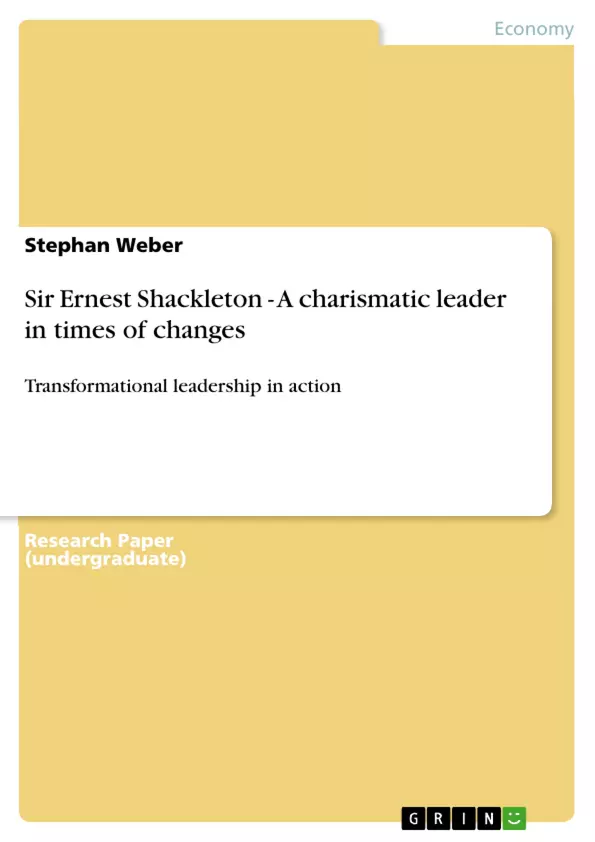Characteristics of today’s business world and selection of a appropriate leader
The literature is full of theories and explanations, why and how leader behave in certain situation, and what a perfect leader must have to perform outstanding. With the concepts and the definition it became clearer that leadership appears in groups with the result of changes.
A closer look inside the business world today shows, that a lot of crisis takes place in various companies every day. Inherent with the globalization and the information availability and transparency is also that business cycles become faster and faster. Thereby only companies which are organized and structured very flexible, and are able to adapt themselves on new situations are successful.
So the task for a manager is to be prepared on new changing situation, to foresee situations and to solve upcoming crisis successfully.
Due to that the following paper is based on a personality and a successful leader of the past: Eric Shackleton. As he was able to master his extreme crisis situations very successful, he is also today a very respected and admired person and a architype for todays manager.
To learn from theories is more effective by applying them to an existing situation. Due to that in this paper a short description of Shackleton, his live and personality takes place in order to give and insight in his actions. Thereby special characteristics and actions of Shackletons are pointed out. Based on that, the analytical steps are made, with the use of charismatic as well as transformational leadership theories. Thereby a justification of those theories is made as well as the differences of those is highlighted.
In the end a transformation into today´s buisness life is made.
Table of Contents
- I. Introduction: Wording -Leadership
- II. Characteristics of today's business world and selection of a appropriate leader
- III. Shackleton Proposal of Personality
- A. Birth and School
- B. First Career steps and experiences
- C. Endurance expedition - Preparation phase
- D. 1914–1916 Endurance Expedition
- 1. Detailed Planning and contingency plans for nearly every situation
- 2. Establishment of an outstanding team spirit within the crew.……........
- IV. Account: Selection of appropriate theory for Shackleton and the crisis situation
- V. Critical review on the charismatic and transformational leadership theory...
- VI. Conclusion and Outlook
Objectives and Key Themes
This text aims to explore the concept of leadership through the lens of Sir Ernest Shackleton's life and expeditions. It delves into the characteristics of effective leadership, particularly in crisis situations, and analyzes how Shackleton's actions embody different leadership theories, specifically charismatic and transformational leadership.
- The nature of leadership and its various dimensions
- The importance of effective leadership in crisis situations
- The application of charismatic and transformational leadership theories to Shackleton's expeditions
- The characteristics of a successful leader, particularly in challenging environments
- The role of team dynamics and individual contributions in achieving collective goals
Chapter Summaries
- I. Introduction: Wording -Leadership: This chapter introduces the concept of leadership, outlining its various definitions and dimensions, and establishing a foundation for the analysis of Shackleton's leadership. It emphasizes the importance of leadership in driving change and achieving collective goals.
- II. Characteristics of today's business world and selection of a appropriate leader: This chapter highlights the dynamic and challenging nature of the contemporary business world, emphasizing the need for leaders capable of navigating crisis situations and driving organizational adaptability. It sets the stage for exploring Shackleton's leadership in a context relevant to modern business practices.
- III. Shackleton Proposal of Personality: This chapter presents an overview of Shackleton's life and early experiences, focusing on his personal development and the factors that shaped his leadership style. It covers his early career steps, including his participation in the "Discovery Expedition" and the challenges he faced during those early years.
- IV. Account: Selection of appropriate theory for Shackleton and the crisis situation: This chapter examines Shackleton's leadership in the context of the Endurance Expedition, focusing on the challenges faced by the crew and the strategies employed by Shackleton to overcome them. It delves into the application of charismatic and transformational leadership theories to Shackleton's actions.
- V. Critical review on the charismatic and transformational leadership theory...: This chapter provides a critical analysis of charismatic and transformational leadership theories, applying them to Shackleton's leadership style and highlighting their strengths and limitations in different contexts.
Keywords
The text focuses on themes like leadership, crisis management, charismatic leadership, transformational leadership, team dynamics, Antarctic exploration, Sir Ernest Shackleton, the Endurance Expedition, and the application of leadership theories to real-world situations.
- Quote paper
- Stephan Weber (Author), 2008, Sir Ernest Shackleton - A charismatic leader in times of changes, Munich, GRIN Verlag, https://www.grin.com/document/88090



